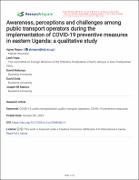| dc.description.abstract | Public transportation plays a vital role in increasing transmission of COVID-19 due to the high-risk confined spaces in vehicles. It is therefore very crucial to employ the use of COVID-19 prevention measures during the use of public transportation to reduce risk of COVID-19 transmission. The success of the implementation and use of these measures depends largely on the public transportation users. We aimed at exploring the awareness, perceptions and challenges among public transport operators during the implementation of COVID-19 preventive measures in Eastern Uganda.
This qualitative study was done in Eastern Uganda between January and February 2021. We conducted four focus group discussions, six in-depth interviews and three key informant interviews to document the awareness, perceptions and challenges faced by public transport operators including 10 boda boda riders, 19 taxi operators and 11 truck (cargo) transporters. All interviews were audio-recorded, transcribed verbatim, and analyzed using NVIVO software Version 12 plus using a thematic framework approach.
Generally public transport operators were aware of that COVID-19 exists, its symptoms, how it’s transmitted and ways in which it can be prevented.. However, they were not aware of what causes it and had misconceptions that it’s spread through food and mosquitoes. Meanwhile some participants perceived COVID-19 as non-existent and that it was manufactured as a biological weapon. Some COVID-19 measures were perceived as having worked well during the pandemic like putting sanctions at the country borders, vaccination, observing hand hygiene, wearing a face mask, avoiding to touch the ‘soft parts’, quarantining in a hospital setting and social distancing. The COVID-19 preventive measures perceived as having not worked well were: home isolation, covid vaccination, using alcohol-based hand sanitizer, setting up curfew time, wearing a face mask, and reducing the number of passengers in the taxis and other public transportation vehicles. Challenges faced were mainly: financial loss resulting from reduction of passengers that used public transportation and setting up of curfew time, passengers not being able to use alcohol base hand sanitizer due to religious beliefs, loss of trust in public transportation by the public, hostility and defiance from passengers, competition for passengers among public transport operators and being mistreated by implementers of COVID-19 preventive measures like police. Various key players in the implementation of COVID-19 preventive measures included: the government, health workers, media, leaders in public transport and the police.
Our study brings to light insights on the likely challenges that impede the use of preventive measures in public transportation use during an epidemic / pandemic like COVID-19 which could potentially escalate transmission. Focus should be put to the demystification of myths on COVID-19. Public transport passengers should be sensitized on risk of COVID-19 transmission during public transportation use and on the importance of complying with COVID-19 preventive measures. We recommend further exploration on the challenges faced by the public transportation passengers in implementing preventive measures in the event of an epidemic like COVID-19. | en_US |


